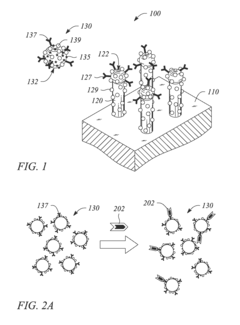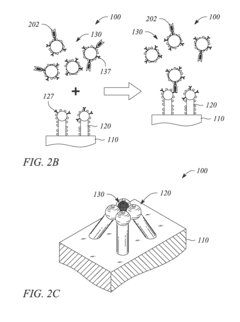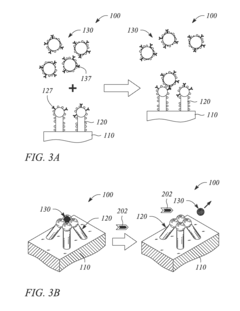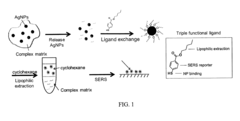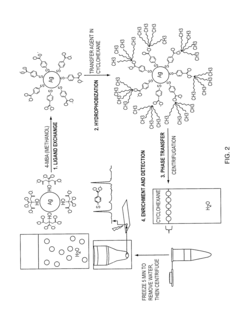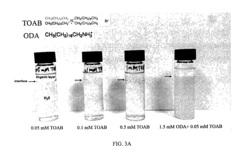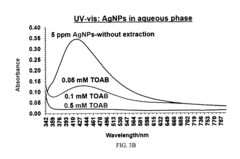Why SERS Substrates Are Critical in Bio-Sensor Developments
OCT 11, 20259 MIN READ
Generate Your Research Report Instantly with AI Agent
Patsnap Eureka helps you evaluate technical feasibility & market potential.
SERS Substrate Technology Background and Objectives
Surface-Enhanced Raman Spectroscopy (SERS) has evolved significantly since its discovery in the 1970s, transforming from a curious optical phenomenon to a powerful analytical technique. The journey began with the observation of enhanced Raman signals from pyridine molecules adsorbed on roughened silver electrodes, which led to the recognition of SERS as a distinct spectroscopic method. Over subsequent decades, researchers have systematically explored the fundamental mechanisms behind SERS, primarily electromagnetic enhancement and chemical enhancement, establishing a solid theoretical foundation for this technology.
The evolution of SERS substrate technology has been particularly remarkable, progressing from simple roughened metal surfaces to sophisticated nanostructured materials engineered at the molecular level. This technological advancement has been driven by the increasing demand for highly sensitive and selective biosensing platforms capable of detecting biomolecules at extremely low concentrations, even down to single-molecule levels in some cases.
In the context of biosensor development, SERS substrates serve as the critical interface between the target analyte and the detection system. These substrates are specifically designed to generate localized surface plasmon resonances (LSPRs) that dramatically amplify Raman signals from nearby molecules. The enhancement factors achieved can reach orders of 10^6 to 10^10, enabling detection sensitivities far beyond conventional spectroscopic methods.
The current technological trajectory is focused on developing SERS substrates with greater reproducibility, stability, and specificity for biological applications. Researchers are exploring various nanofabrication techniques, including lithography, self-assembly, and template-directed synthesis, to create substrates with precisely controlled morphologies and plasmonic properties. Additionally, there is growing interest in flexible and biodegradable SERS substrates that can be integrated into wearable and implantable biosensing devices.
The primary objective in SERS substrate development for biosensing applications is to achieve reliable, cost-effective platforms capable of rapid, sensitive, and specific detection of biomarkers in complex biological matrices. This includes the detection of proteins, nucleic acids, metabolites, and pathogens in clinical samples, environmental monitoring, and food safety testing. Researchers aim to overcome current limitations such as batch-to-batch variability, signal reproducibility, and substrate shelf-life.
Looking forward, the field is moving toward multifunctional SERS substrates that combine detection capabilities with therapeutic functionalities, creating theranostic platforms. There is also significant interest in developing machine learning algorithms to analyze SERS spectral data more effectively, potentially enabling real-time monitoring of biological processes and disease progression. The convergence of SERS technology with microfluidics and portable Raman instrumentation is expected to revolutionize point-of-care diagnostics and personalized medicine in the coming decade.
The evolution of SERS substrate technology has been particularly remarkable, progressing from simple roughened metal surfaces to sophisticated nanostructured materials engineered at the molecular level. This technological advancement has been driven by the increasing demand for highly sensitive and selective biosensing platforms capable of detecting biomolecules at extremely low concentrations, even down to single-molecule levels in some cases.
In the context of biosensor development, SERS substrates serve as the critical interface between the target analyte and the detection system. These substrates are specifically designed to generate localized surface plasmon resonances (LSPRs) that dramatically amplify Raman signals from nearby molecules. The enhancement factors achieved can reach orders of 10^6 to 10^10, enabling detection sensitivities far beyond conventional spectroscopic methods.
The current technological trajectory is focused on developing SERS substrates with greater reproducibility, stability, and specificity for biological applications. Researchers are exploring various nanofabrication techniques, including lithography, self-assembly, and template-directed synthesis, to create substrates with precisely controlled morphologies and plasmonic properties. Additionally, there is growing interest in flexible and biodegradable SERS substrates that can be integrated into wearable and implantable biosensing devices.
The primary objective in SERS substrate development for biosensing applications is to achieve reliable, cost-effective platforms capable of rapid, sensitive, and specific detection of biomarkers in complex biological matrices. This includes the detection of proteins, nucleic acids, metabolites, and pathogens in clinical samples, environmental monitoring, and food safety testing. Researchers aim to overcome current limitations such as batch-to-batch variability, signal reproducibility, and substrate shelf-life.
Looking forward, the field is moving toward multifunctional SERS substrates that combine detection capabilities with therapeutic functionalities, creating theranostic platforms. There is also significant interest in developing machine learning algorithms to analyze SERS spectral data more effectively, potentially enabling real-time monitoring of biological processes and disease progression. The convergence of SERS technology with microfluidics and portable Raman instrumentation is expected to revolutionize point-of-care diagnostics and personalized medicine in the coming decade.
Market Analysis for SERS-based Biosensors
The global market for SERS-based biosensors is experiencing robust growth, driven by increasing demand for rapid, sensitive, and portable diagnostic solutions across healthcare, environmental monitoring, and food safety sectors. Current market valuations indicate that the SERS biosensor market reached approximately 320 million USD in 2022, with projections suggesting a compound annual growth rate (CAGR) of 14-16% through 2030, potentially reaching 1.2 billion USD by the end of the decade.
Healthcare applications dominate the market landscape, accounting for nearly 60% of current SERS biosensor deployments. Within this segment, point-of-care diagnostics represents the fastest-growing application area, responding to the global shift toward decentralized healthcare delivery models. The COVID-19 pandemic significantly accelerated market adoption, demonstrating the value of rapid, field-deployable sensing technologies during public health emergencies.
Geographically, North America leads the market with approximately 40% share, followed by Europe (30%) and Asia-Pacific (25%). However, the Asia-Pacific region is expected to witness the highest growth rate over the next five years, driven by increasing healthcare expenditure, expanding research infrastructure, and government initiatives supporting biotech innovation in countries like China, Japan, and South Korea.
From an end-user perspective, research institutions and pharmaceutical companies currently constitute the largest customer segments. However, clinical laboratories and hospitals are rapidly increasing their adoption rates as SERS technologies become more standardized and regulatory pathways become clearer. The market for consumer-oriented SERS biosensors remains nascent but shows promising growth potential, particularly for applications in personalized health monitoring.
Key market drivers include the rising incidence of infectious diseases, growing demand for minimally invasive diagnostic procedures, and increasing focus on early disease detection. Additionally, technological advancements in nanofabrication techniques are progressively reducing production costs of SERS substrates, making these technologies more economically viable for widespread implementation.
Market challenges primarily revolve around standardization issues, regulatory hurdles, and the relatively high cost of high-performance SERS substrates. The lack of established quality control metrics for SERS substrates remains a significant barrier to broader commercial adoption, particularly in highly regulated sectors like clinical diagnostics.
Emerging market opportunities include integration with smartphone-based detection platforms, development of multiplexed SERS assays capable of detecting multiple biomarkers simultaneously, and expansion into veterinary diagnostics and agricultural monitoring applications. The convergence of SERS technology with artificial intelligence for automated signal processing and interpretation represents another high-potential growth avenue.
Healthcare applications dominate the market landscape, accounting for nearly 60% of current SERS biosensor deployments. Within this segment, point-of-care diagnostics represents the fastest-growing application area, responding to the global shift toward decentralized healthcare delivery models. The COVID-19 pandemic significantly accelerated market adoption, demonstrating the value of rapid, field-deployable sensing technologies during public health emergencies.
Geographically, North America leads the market with approximately 40% share, followed by Europe (30%) and Asia-Pacific (25%). However, the Asia-Pacific region is expected to witness the highest growth rate over the next five years, driven by increasing healthcare expenditure, expanding research infrastructure, and government initiatives supporting biotech innovation in countries like China, Japan, and South Korea.
From an end-user perspective, research institutions and pharmaceutical companies currently constitute the largest customer segments. However, clinical laboratories and hospitals are rapidly increasing their adoption rates as SERS technologies become more standardized and regulatory pathways become clearer. The market for consumer-oriented SERS biosensors remains nascent but shows promising growth potential, particularly for applications in personalized health monitoring.
Key market drivers include the rising incidence of infectious diseases, growing demand for minimally invasive diagnostic procedures, and increasing focus on early disease detection. Additionally, technological advancements in nanofabrication techniques are progressively reducing production costs of SERS substrates, making these technologies more economically viable for widespread implementation.
Market challenges primarily revolve around standardization issues, regulatory hurdles, and the relatively high cost of high-performance SERS substrates. The lack of established quality control metrics for SERS substrates remains a significant barrier to broader commercial adoption, particularly in highly regulated sectors like clinical diagnostics.
Emerging market opportunities include integration with smartphone-based detection platforms, development of multiplexed SERS assays capable of detecting multiple biomarkers simultaneously, and expansion into veterinary diagnostics and agricultural monitoring applications. The convergence of SERS technology with artificial intelligence for automated signal processing and interpretation represents another high-potential growth avenue.
Current SERS Substrate Challenges and Limitations
Despite significant advancements in Surface-Enhanced Raman Spectroscopy (SERS) substrate technology, several critical challenges continue to impede their widespread application in biosensing. One of the most persistent issues is reproducibility. Current manufacturing processes often yield substrates with inconsistent enhancement factors across their surface area, resulting in significant signal variations between measurements. This inconsistency severely limits quantitative analysis capabilities, which are essential for reliable biosensor applications in clinical settings.
Sensitivity limitations represent another major hurdle. While SERS can theoretically detect single molecules, practical implementations frequently fall short of this potential. Many commercially available substrates provide insufficient enhancement factors for detecting low-concentration biomarkers, particularly in complex biological matrices where target molecules may be present at sub-nanomolar concentrations. This sensitivity gap restricts the application of SERS in early disease detection scenarios where biomarker concentrations are extremely low.
Stability issues further complicate SERS substrate utilization in biosensing. Many substrates exhibit performance degradation over time due to oxidation, contamination, or structural changes in the metallic nanostructures. This limited shelf-life increases operational costs and reduces reliability in field applications. Additionally, when exposed to biological samples, protein adsorption and biofouling can rapidly diminish signal enhancement capabilities, necessitating complex sample preparation protocols.
Selectivity remains a significant challenge, particularly in complex biological environments. Current SERS substrates often lack the specificity needed to distinguish between similar biomolecules, resulting in spectral interference and false readings. While functionalization with recognition elements like antibodies or aptamers can improve selectivity, these modifications frequently reduce enhancement factors and introduce additional variability.
Cost and scalability concerns continue to restrict widespread adoption. High-performance SERS substrates typically require sophisticated nanofabrication techniques such as electron-beam lithography or focused ion beam milling, which are expensive and difficult to scale. Although colloidal-based substrates offer more economical alternatives, they generally provide less consistent enhancement and poorer reproducibility.
Biocompatibility presents additional complications for in vivo or continuous monitoring applications. Many high-performance SERS substrates incorporate materials that may be cytotoxic or trigger immune responses. Furthermore, the long-term stability of these materials in physiological environments remains inadequately characterized, raising concerns about their suitability for implantable biosensors or point-of-care diagnostics.
Sensitivity limitations represent another major hurdle. While SERS can theoretically detect single molecules, practical implementations frequently fall short of this potential. Many commercially available substrates provide insufficient enhancement factors for detecting low-concentration biomarkers, particularly in complex biological matrices where target molecules may be present at sub-nanomolar concentrations. This sensitivity gap restricts the application of SERS in early disease detection scenarios where biomarker concentrations are extremely low.
Stability issues further complicate SERS substrate utilization in biosensing. Many substrates exhibit performance degradation over time due to oxidation, contamination, or structural changes in the metallic nanostructures. This limited shelf-life increases operational costs and reduces reliability in field applications. Additionally, when exposed to biological samples, protein adsorption and biofouling can rapidly diminish signal enhancement capabilities, necessitating complex sample preparation protocols.
Selectivity remains a significant challenge, particularly in complex biological environments. Current SERS substrates often lack the specificity needed to distinguish between similar biomolecules, resulting in spectral interference and false readings. While functionalization with recognition elements like antibodies or aptamers can improve selectivity, these modifications frequently reduce enhancement factors and introduce additional variability.
Cost and scalability concerns continue to restrict widespread adoption. High-performance SERS substrates typically require sophisticated nanofabrication techniques such as electron-beam lithography or focused ion beam milling, which are expensive and difficult to scale. Although colloidal-based substrates offer more economical alternatives, they generally provide less consistent enhancement and poorer reproducibility.
Biocompatibility presents additional complications for in vivo or continuous monitoring applications. Many high-performance SERS substrates incorporate materials that may be cytotoxic or trigger immune responses. Furthermore, the long-term stability of these materials in physiological environments remains inadequately characterized, raising concerns about their suitability for implantable biosensors or point-of-care diagnostics.
Current SERS Substrate Design Solutions
01 Metallic nanostructured SERS substrates
Metallic nanostructured surfaces are commonly used as SERS substrates due to their ability to enhance Raman signals through plasmonic effects. These substrates typically consist of noble metals like gold, silver, or copper arranged in specific patterns or structures such as nanoparticles, nanorods, or nanogaps. The size, shape, and spacing of these metallic nanostructures can be optimized to achieve maximum signal enhancement for various analytical applications.- Metal nanostructure-based SERS substrates: Metal nanostructures, particularly those made of gold, silver, or copper, serve as effective SERS substrates due to their plasmonic properties. These substrates can be fabricated in various forms including nanoparticles, nanorods, and nanopatterned surfaces. The localized surface plasmon resonance generated by these metal nanostructures significantly enhances the Raman signal, allowing for highly sensitive molecular detection. The enhancement factor can reach several orders of magnitude, making these substrates suitable for trace analysis applications.
- Semiconductor-based SERS substrates: Semiconductor materials can be used as SERS substrates, offering advantages such as tunable optical properties and compatibility with existing semiconductor fabrication processes. These substrates often incorporate materials like silicon, titanium dioxide, or zinc oxide, sometimes in combination with metal nanoparticles to create hybrid structures. Semiconductor-based SERS substrates can provide enhanced stability and reproducibility compared to pure metal substrates, making them suitable for integrated sensing platforms and portable detection devices.
- Flexible and wearable SERS substrates: Flexible SERS substrates are designed for applications requiring conformability to irregular surfaces or integration into wearable devices. These substrates typically use polymer or paper-based materials as supporting platforms, with metal nanostructures deposited or embedded within them. The flexibility allows for direct contact with various sample surfaces, including biological tissues, while maintaining SERS enhancement capabilities. These substrates enable real-time monitoring in diverse environments and can be incorporated into point-of-care diagnostic devices.
- 3D structured SERS substrates: Three-dimensional SERS substrates offer increased surface area and multiple hot spots for enhanced Raman signal detection. These substrates can be fabricated using techniques such as layer-by-layer assembly, template-assisted growth, or 3D printing. The three-dimensional architecture provides a larger number of binding sites for target molecules and creates complex plasmonic coupling effects that further amplify the SERS signal. These substrates are particularly useful for ultra-sensitive detection applications and can achieve lower detection limits compared to conventional 2D substrates.
- Functionalized SERS substrates for specific target detection: Functionalized SERS substrates incorporate specific recognition elements such as antibodies, aptamers, or molecularly imprinted polymers to enable selective detection of target analytes. The surface of these substrates is modified with functional groups that can selectively bind to particular molecules or biological entities. This approach combines the high sensitivity of SERS with high selectivity, reducing interference from complex sample matrices. These substrates are particularly valuable for biosensing applications, environmental monitoring, and food safety testing where specific target detection is required.
02 Fabrication methods for SERS substrates
Various fabrication techniques are employed to create effective SERS substrates with controlled morphology and reproducible enhancement factors. These methods include lithographic techniques, chemical synthesis, template-assisted growth, and self-assembly processes. Advanced manufacturing approaches like nanoimprinting, electron beam lithography, and colloidal assembly enable precise control over the substrate architecture, which is crucial for achieving consistent analytical performance.Expand Specific Solutions03 Flexible and portable SERS substrates
Flexible SERS substrates are designed for field applications and point-of-care diagnostics. These substrates are typically fabricated on polymer or paper-based materials that can conform to various surfaces while maintaining their enhancement capabilities. The flexibility allows for direct sampling from curved surfaces and integration into portable analytical devices, enabling on-site detection of analytes in environmental monitoring, food safety testing, and medical diagnostics.Expand Specific Solutions04 SERS substrate integration with microfluidics
Integration of SERS substrates with microfluidic systems enables automated sample handling and analysis. These integrated platforms combine the high sensitivity of SERS detection with precise fluid control, allowing for continuous monitoring, reduced sample volumes, and multiplexed analysis. Microfluidic SERS devices can incorporate sample preparation steps, concentration mechanisms, and multiple detection zones, enhancing the overall analytical performance for complex sample matrices.Expand Specific Solutions05 Novel materials for enhanced SERS performance
Research into novel materials for SERS substrates focuses on improving sensitivity, selectivity, and stability. These materials include hybrid structures combining metals with semiconductors, graphene, metal-organic frameworks, or polymers. Some approaches involve incorporating molecular recognition elements directly onto the substrate surface to enhance selectivity. Advanced materials can provide additional functionalities such as self-cleaning properties, extended shelf-life, and broader spectral response ranges.Expand Specific Solutions
Leading Companies and Research Institutions in SERS Field
Surface-Enhanced Raman Spectroscopy (SERS) substrates have emerged as critical components in bio-sensor development, with the market currently in a growth phase characterized by increasing commercial applications. The global SERS substrate market is expanding rapidly, driven by healthcare diagnostics and environmental monitoring demands. Technologically, the field shows varying maturity levels across different applications, with academic institutions (Boston University, National University of Singapore, Jilin University) leading fundamental research while companies like Corning, Seiko Epson, and HP Development are advancing commercial implementations. Research organizations such as Agency for Science, Technology & Research and Shanghai Institute of Ceramics are bridging the gap between academic discoveries and industrial applications, focusing on enhancing substrate sensitivity, reproducibility, and cost-effectiveness for next-generation biosensing platforms.
National University of Singapore
Technical Solution: NUS has developed sophisticated SERS substrate technologies through its interdisciplinary research programs. Their approach focuses on creating highly ordered nanostructured arrays using advanced nanofabrication techniques including colloidal lithography and template-assisted assembly. NUS researchers have pioneered hierarchical SERS substrates with multi-scale roughness that creates cascaded enhancement effects, achieving enhancement factors exceeding 10^8 with exceptional reproducibility. A significant innovation is their development of environmentally responsive SERS substrates that modulate their enhancement properties in response to specific biological conditions (pH, temperature, or target molecule presence), enabling intelligent biosensing capabilities. NUS has also created biodegradable SERS substrates for in vivo biosensing applications that provide temporary diagnostic capabilities before safely breaking down. Their research extends to machine learning algorithms that analyze SERS spectral patterns to identify biomarkers in complex biological samples with minimal sample preparation, significantly improving clinical applicability.
Strengths: Highly innovative designs with multi-functional capabilities; strong integration with computational analysis; environmentally responsive properties for advanced applications. Weaknesses: Complex fabrication processes may limit mass production; some technologies still in development phase rather than commercial implementation.
Agency for Science, Technology & Research
Technical Solution: A*STAR has developed cutting-edge SERS substrate technologies through collaborative research across its institutes. Their approach combines nanofabrication expertise with advanced materials science to create highly sensitive SERS platforms. A*STAR's substrates utilize precisely controlled metal nanostructures (primarily gold and silver) deposited on various substrate materials using techniques like electron beam lithography and nanoimprint lithography. These substrates achieve enhancement factors of 10^6-10^8 with exceptional reproducibility. A key innovation is their development of flexible SERS substrates that conform to irregular surfaces while maintaining enhancement properties, enabling new biosensing applications. A*STAR has pioneered reusable SERS substrates with specialized cleaning protocols that maintain performance across multiple testing cycles, reducing per-test costs. Their research has also yielded novel composite substrates incorporating graphene and other 2D materials with plasmonic nanostructures, creating synergistic enhancement effects for improved sensitivity in biomarker detection.
Strengths: Cutting-edge research combining multiple advanced materials; flexible substrate options for diverse applications; strong intellectual property portfolio. Weaknesses: Some technologies still in research phase rather than commercial production; requires specialized expertise for optimal implementation.
Key SERS Enhancement Mechanisms and Innovations
Surface enhanced raman spectroscopy sensor, system and method of sensing
PatentInactiveUS9588048B2
Innovation
- A SERS sensor system comprising a sensing substrate with movable nanorods and functionalized nanoparticles, where the nanorods are anchored at one end and can bend into close proximity to enhance Raman signal detection, and an illumination source is directed at these ends to generate and detect Raman signals from the analyte.
Systems and methods for extraction and surface-enhanced raman spectroscopy detection of metal nanoparticles
PatentInactiveUS20170052123A1
Innovation
- The use of surface-enhanced Raman spectroscopy (SERS) combined with organic substances like ligands and flavonoids to extract and detect MNPs, facilitating their separation and providing a distinct Raman signal for imaging, allowing for nondestructive and sensitive analysis.
Biocompatibility and Safety Considerations
The integration of SERS substrates into biosensing applications necessitates rigorous evaluation of biocompatibility and safety profiles. When these substrates interface with biological systems, potential cytotoxicity becomes a primary concern, particularly with metallic nanostructures that form the backbone of SERS-active surfaces. Gold and silver nanoparticles, while offering excellent plasmonic properties, exhibit varying degrees of biocompatibility that must be thoroughly assessed before clinical implementation.
Surface chemistry modifications play a crucial role in enhancing biocompatibility while maintaining SERS enhancement capabilities. Functionalization strategies using biocompatible polymers like polyethylene glycol (PEG) or biomolecules such as proteins and antibodies can effectively shield biological systems from direct contact with potentially harmful substrate components. These surface modifications not only improve safety profiles but also can enhance target specificity in complex biological matrices.
Long-term stability of SERS substrates in biological environments presents another significant challenge. Degradation products from less stable substrates may introduce unexpected toxicity or compromise analytical performance over time. Recent research has focused on developing encapsulation techniques and corrosion-resistant coatings that preserve substrate integrity while minimizing potential adverse effects on surrounding tissues or cells.
Regulatory considerations for SERS-based biosensors demand comprehensive safety evaluation protocols. Current frameworks require extensive in vitro and in vivo testing to characterize potential immunogenicity, inflammatory responses, and systemic toxicity. The FDA and equivalent international regulatory bodies have established specific guidelines for nanomaterial-based diagnostic devices that SERS substrate developers must navigate to achieve clinical approval.
Environmental impact assessments have gained increasing importance in SERS substrate development. The potential release of nanoparticles into ecosystems through disposal or degradation pathways necessitates lifecycle analysis of these materials. Sustainable design approaches are emerging that consider end-of-life management strategies, including biodegradable substrate components or recyclable elements that minimize environmental footprint.
Standardization efforts for biocompatibility testing of SERS substrates remain in nascent stages. The scientific community is working toward establishing consensus protocols that address the unique properties of these materials. Harmonized testing methodologies would accelerate clinical translation by providing clear benchmarks for safety evaluation and facilitating regulatory approval processes across different jurisdictions.
Surface chemistry modifications play a crucial role in enhancing biocompatibility while maintaining SERS enhancement capabilities. Functionalization strategies using biocompatible polymers like polyethylene glycol (PEG) or biomolecules such as proteins and antibodies can effectively shield biological systems from direct contact with potentially harmful substrate components. These surface modifications not only improve safety profiles but also can enhance target specificity in complex biological matrices.
Long-term stability of SERS substrates in biological environments presents another significant challenge. Degradation products from less stable substrates may introduce unexpected toxicity or compromise analytical performance over time. Recent research has focused on developing encapsulation techniques and corrosion-resistant coatings that preserve substrate integrity while minimizing potential adverse effects on surrounding tissues or cells.
Regulatory considerations for SERS-based biosensors demand comprehensive safety evaluation protocols. Current frameworks require extensive in vitro and in vivo testing to characterize potential immunogenicity, inflammatory responses, and systemic toxicity. The FDA and equivalent international regulatory bodies have established specific guidelines for nanomaterial-based diagnostic devices that SERS substrate developers must navigate to achieve clinical approval.
Environmental impact assessments have gained increasing importance in SERS substrate development. The potential release of nanoparticles into ecosystems through disposal or degradation pathways necessitates lifecycle analysis of these materials. Sustainable design approaches are emerging that consider end-of-life management strategies, including biodegradable substrate components or recyclable elements that minimize environmental footprint.
Standardization efforts for biocompatibility testing of SERS substrates remain in nascent stages. The scientific community is working toward establishing consensus protocols that address the unique properties of these materials. Harmonized testing methodologies would accelerate clinical translation by providing clear benchmarks for safety evaluation and facilitating regulatory approval processes across different jurisdictions.
Commercialization Pathways for SERS Biosensors
The commercialization of SERS biosensors represents a significant opportunity for translating laboratory innovations into market-ready products. Currently, several pathways exist for bringing these advanced sensing technologies to commercial fruition, each with distinct advantages and challenges.
Primary commercialization routes include licensing technologies to established biomedical companies, forming startup ventures, and pursuing strategic partnerships with industry leaders. The licensing approach offers rapid market entry by leveraging existing distribution networks and manufacturing capabilities, though innovators may sacrifice control over product development and receive limited royalties. This pathway has proven successful for university-developed SERS substrate technologies that require substantial capital investment for scale-up.
Startup formation provides greater autonomy and potential financial returns but demands significant entrepreneurial expertise and investment capital. Several SERS biosensor startups have emerged in recent years, particularly focusing on point-of-care diagnostics and environmental monitoring applications. These ventures typically require 3-5 years of development before achieving sustainable revenue streams.
Strategic partnerships between research institutions and industry players offer a balanced approach, combining academic innovation with commercial resources. Such collaborations have accelerated the development of standardized SERS substrates for specific biosensing applications, addressing the critical challenge of reproducibility in commercial settings.
Market entry strategies vary significantly based on application domains. Medical diagnostics applications face rigorous regulatory hurdles requiring extensive clinical validation, with FDA approval processes potentially extending commercialization timelines by 2-4 years. Conversely, environmental monitoring and food safety applications often present more accessible regulatory pathways, enabling faster market penetration.
Manufacturing scalability remains a fundamental challenge, as many laboratory-optimized SERS substrates employ fabrication techniques ill-suited for mass production. Recent innovations in nanoimprint lithography and roll-to-roll processing show promise for cost-effective, high-volume manufacturing of consistent SERS substrates. Companies successfully navigating this transition have typically reduced production costs by 60-80% compared to laboratory-scale fabrication.
Pricing models for SERS biosensor technologies continue to evolve, with trends moving toward consumable-based approaches where the detection platform is provided at reduced cost while revenue is generated through specialized SERS substrate sales. This model aligns with healthcare industry practices and creates recurring revenue streams essential for sustainable commercialization.
Primary commercialization routes include licensing technologies to established biomedical companies, forming startup ventures, and pursuing strategic partnerships with industry leaders. The licensing approach offers rapid market entry by leveraging existing distribution networks and manufacturing capabilities, though innovators may sacrifice control over product development and receive limited royalties. This pathway has proven successful for university-developed SERS substrate technologies that require substantial capital investment for scale-up.
Startup formation provides greater autonomy and potential financial returns but demands significant entrepreneurial expertise and investment capital. Several SERS biosensor startups have emerged in recent years, particularly focusing on point-of-care diagnostics and environmental monitoring applications. These ventures typically require 3-5 years of development before achieving sustainable revenue streams.
Strategic partnerships between research institutions and industry players offer a balanced approach, combining academic innovation with commercial resources. Such collaborations have accelerated the development of standardized SERS substrates for specific biosensing applications, addressing the critical challenge of reproducibility in commercial settings.
Market entry strategies vary significantly based on application domains. Medical diagnostics applications face rigorous regulatory hurdles requiring extensive clinical validation, with FDA approval processes potentially extending commercialization timelines by 2-4 years. Conversely, environmental monitoring and food safety applications often present more accessible regulatory pathways, enabling faster market penetration.
Manufacturing scalability remains a fundamental challenge, as many laboratory-optimized SERS substrates employ fabrication techniques ill-suited for mass production. Recent innovations in nanoimprint lithography and roll-to-roll processing show promise for cost-effective, high-volume manufacturing of consistent SERS substrates. Companies successfully navigating this transition have typically reduced production costs by 60-80% compared to laboratory-scale fabrication.
Pricing models for SERS biosensor technologies continue to evolve, with trends moving toward consumable-based approaches where the detection platform is provided at reduced cost while revenue is generated through specialized SERS substrate sales. This model aligns with healthcare industry practices and creates recurring revenue streams essential for sustainable commercialization.
Unlock deeper insights with Patsnap Eureka Quick Research — get a full tech report to explore trends and direct your research. Try now!
Generate Your Research Report Instantly with AI Agent
Supercharge your innovation with Patsnap Eureka AI Agent Platform!

